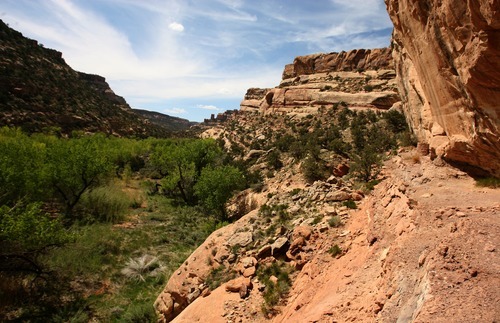This is an archived article that was published on sltrib.com in 2011, and information in the article may be outdated. It is provided only for personal research purposes and may not be reprinted.
Washington • The Interior Department on Thursday proposed setting aside hundreds of thousands of acres of public land in Utah as wilderness, though it passed on pushing protection for several other areas following objections from local officials.
Interior's plan, which would require congressional approval, includes designating three spots in Grand County as wilderness: Desolation Canyon, Mill Creek Canyon and Westwater Canyon, areas that environmentalists say are treasured landscapes that need to be kept free of development and oil and gas leasing.
Administration officials stressed that it did not include other parts of Utah because of objections by county leaders who didn't want to see any more wilderness.
"The foundation of this report to Congress is a sense that there is community support for these designations and in the case of Utah, it doesn't include every place in Utah that people have said we ought to move forward and make it into a wilderness area," Secretary Ken Salazar said in response to a question by The Salt Lake Tribune. "But these are special places in Utah."
Deputy Interior Secretary David Hayes said Grand County officials "specifically recommended" those areas.
"The Utah delegation has emphasized the importance of having county support for any special designations and we're respecting that by identifying these areas," Hayes said.
Elected officials from 22 counties in the state had written Interior to oppose, for the most part, any new wilderness areas within their boundaries.
The Grand County Council said in its letter that it didn't have time by Interior's August deadline to suggest what areas, if any, it wanted protected as wilderness. But the council did submit a 12-year-old wilderness plan that called for protecting some 200,000 acres.
Council Chairman Chris Baird said the council didn't want to form a new wilderness opinion on short notice, and opted to include wilderness goals from its 1990s-era comprehensive plan. The message, in effect, was that the county was OK with any designations mentioned in that plan, including the three that Salazar picked.
"These probably match the definition of wilderness character better than a lot of places," Baird said, "and they also have very little oil or gas interests."
The Utah Association of Counties, which has backed a wilderness-designation process led by individual counties, praised Salazar for honoring members' desire not to participate.
"It's a surprisingly pleasing outcome," said association attorney Mark Ward.
That doesn't mean there won't be more wilderness in the state, Ward said. Counties such as San Juan, Emery and Piute are working on their own processes to pass wilderness legislation, he noted, and it appears that Salazar's recommendations for three new wilderness areas line up with Grand County's goals.
The Interior Department didn't put a number on how many acres the proposed wilderness areas would be, although the Desolation Canyon Wilderness Study Area alone is nearly 300,000 acres.
The Southern Utah Wilderness Alliance blasted the plan as a waste of time. The three Grand County areas already enjoy wilderness-class protections as wilderness study areas, SUWA Associate Director Heidi McIntosh said.
"This doesn't move the ball. It doesn't protect one single new acre," she said.
Desolation Canyon, on a remote stretch of the Green River, has been a focal point for wilderness advocates this year. Numerous outdoor and gear industry executives sent a joint letter to Salazar over the summer asking him to halt the encroachment of gas drilling in the area. Thursday's proposal would not do that.
"The [Desolation Canyon] Wilderness Study Area is beautiful," McIntosh said, "but areas equally worthy of protection exist just outside the boundary. These are the places that really need protection."
The Interior Department appears swayed by Utah's congressional delegation, she said. "They're appealing to the lowest common denominator instead of exercising leadership."
Utah's members of Congress didn't seem overly impressed, though. Rep. Rob Bishop, a Utah Republican and one of Interior's sharpest critics, said he was pleased Salazar respected the counties' requests but added that any future designations should come from the communities involved, "not from dictates out of Washington."
Rep. Jim Matheson, D-Utah, said that Salazar "continues to be tone deaf" about public land issues in Utah and should be following the lead of the Washington County lands bill that brought all interested parties to an agreement on wilderness.
"This is not the way to make progress on public-lands decisions, and it only ensures that we won't see a successful outcome on the ground here," Matheson said.
Sen. Orrin Hatch, R-Utah, said the areas Salazar highlighted would be part of the consideration for more wilderness designations but that discussion needs to happen in Grand County first.
"This is a process that is very difficult and it doesn't help to have unsolicited input coming from the administration," Hatch said. "Any change in the designation of Utah lands should be made through a collaborative process with those closest to the lands."
In response, Salazar said the goal of the process is to work with federal, state and local officials on wilderness designations and the department is hoping for broad support.
"We want to work with the Congress to make these proposals happen," Salazar said. "We certainly worked with Utah in the past. ... I certainly hope and expect that we can do that here."
Brandon Loomis contributed to this report.



